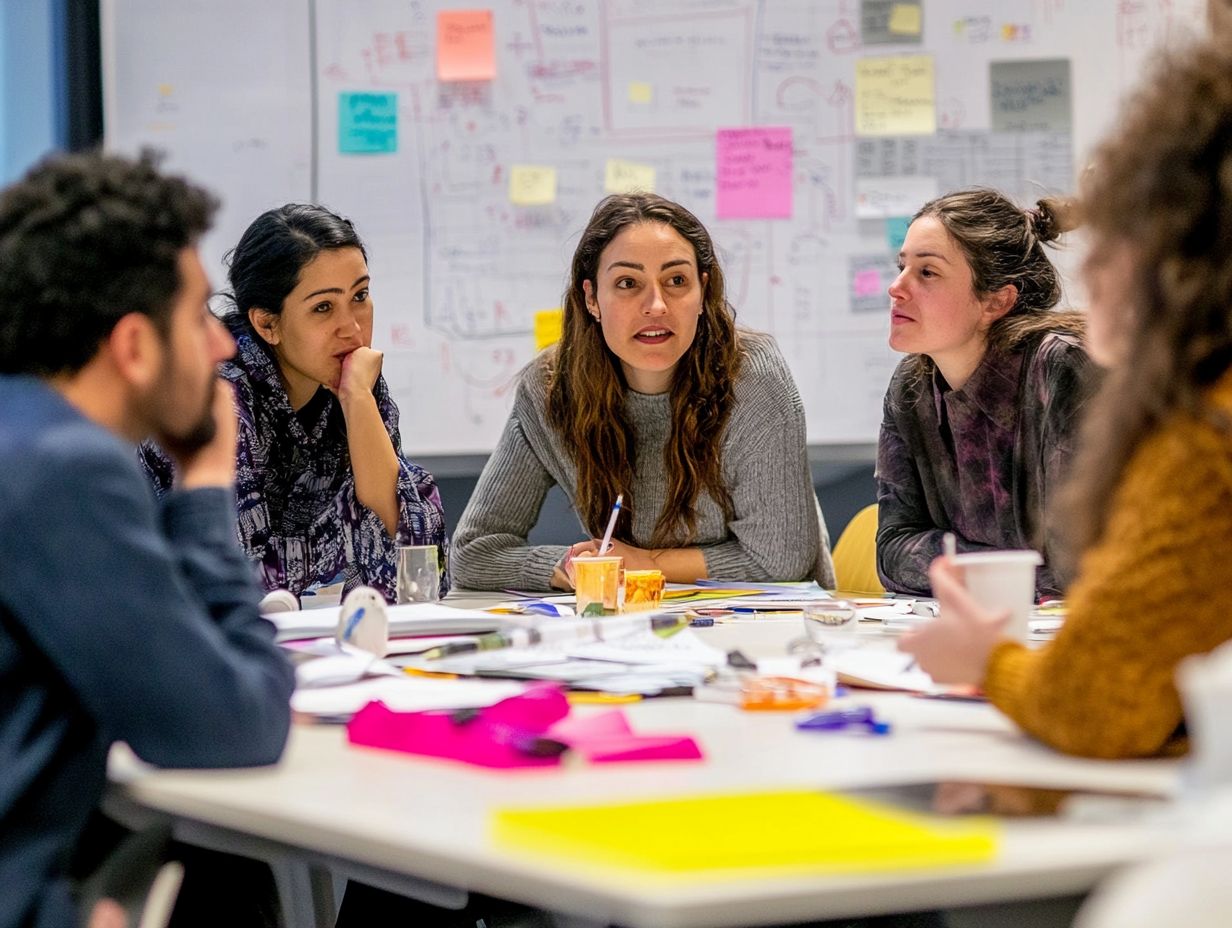What Are the Benefits of Peer Learning in Training?
Peer learning is a dynamic approach that encourages collaboration among learners. It allows them to share their knowledge and skills with one another.
This article delves into the definition and essential components of peer learning. It emphasizes its significant benefits in training environments, such as enhanced learning outcomes and improved communication skills.
It also presents effective strategies for implementing peer learning while addressing common challenges. These include managing group dynamics and accommodating diverse learning styles.
Discover the exciting impact of peer learning today!
Contents
- Key Takeaways:
- Understanding Peer Learning
- The Benefits of Peer Learning in Training
- Ready to Transform Your Training?
- Addressing Challenges and Concerns
- Frequently Asked Questions
- What Are the Benefits of Peer Learning in Training?
- How does peer learning enhance critical thinking skills?
- What role does peer learning play in improving communication skills?
- Can peer learning improve team dynamics?
- How does peer learning benefit trainers?
- What are the long-term effects of peer learning in training?
Key Takeaways:

- Peer learning in training leads to improved learning outcomes by providing students with diverse perspectives and opportunities to practice and reinforce their skills.
- Collaborating with peers in training enhances communication skills and promotes teamwork, which are essential for success in the workplace.
- Peer learning boosts motivation and engagement by creating a supportive and interactive learning environment, allowing students to take ownership of their learning.
Understanding Peer Learning
Grasping the concept of peer learning is crucial for organizations aiming to elevate employee development and cultivate a culture of collaboration. This approach highlights the significance of knowledge sharing among employees, meaning exchanging information and insights among peers. It allows them to draw insights from each other’s experiences and expertise.
Leading companies like Google and Airbnb have seamlessly woven peer learning into their training programs. This has resulted in enhanced employee engagement and retention.
Definition and Key Components
Peer learning is an enriching educational practice where individuals within an organization enhance their knowledge and skills by learning from one another. This collaborative approach fosters an environment of mutual respect and shared growth.
It encourages collective problem-solving and highlights mentorship as a vital aspect. Mentorship allows more experienced team members to guide those who are newer. Feedback loops are essential in this process, reinforcing learning outcomes by providing helpful feedback and shared insights that enable you to refine your skills effectively.
Informal education, often taking place in natural settings like team meetings or casual discussions, complements traditional training methods. This creates a holistic learning environment. These interactive experiences are key to addressing skill gaps, promoting adaptability, and ultimately nurturing a culture of continuous improvement among employees.
The Benefits of Peer Learning in Training
Peer learning transforms training by offering countless benefits. This approach fosters a collaborative environment and contributes to improved retention rates, making it a vital component of effective workforce management.
Improved Learning Outcomes

Peer learning plays a vital role in enhancing your learning outcomes by fostering collaboration among employees. This ultimately leads to better problem-solving skills and bridges any existing skill gaps.
This collaborative approach encourages you to share your diverse experiences and insights. It cultivates an environment where continuous improvement can flourish. For instance, organizations that implement peer mentoring programs often see remarkable advancements in employee performance metrics. Consider a tech company that set up study groups across departments, allowing employees to tackle complex projects together.
This initiative led to a significant 30% reduction in project completion time, illustrating the power of collaboration in boosting learning outcomes. By engaging in peer-led discussions, you and your teammates develop critical thinking skills and innovative solutions, driving overall productivity to new heights.
Enhanced Collaboration and Communication Skills
Engaging in peer learning significantly enhances your collaboration and communication skills, promoting mutual respect while strengthening team dynamics within your organization.
This approach invites you to share diverse perspectives and experiences, nurturing an environment where open dialogue thrives. As you learn from one another, you not only enhance your own skills but also forge a sense of camaraderie that is vital for cohesive teamwork.
The foundation of mutual respect lays the groundwork for trust, allowing you and your colleagues to feel valued and understood.
As you collaborate on various tasks, this collective learning experience fosters a supportive atmosphere where constructive feedback and shared insights flow freely. Ultimately, these interactions contribute to a more agile and innovative workplace culture, enabling you and your team to present your very best.
Increased Motivation and Engagement
By elevating motivation and engagement levels, peer learning enables you to take an active role in your own development.
You also reap the benefits of support from your colleagues. Peer learning gives you new insights and skills and nurtures a sense of belonging within your workplace.
When you participate in casual learning meetings and collaborative projects, you contribute to an environment that celebrates cultural diversity, allowing unique perspectives to shine through.
These dynamic interactions cultivate a vibrant learning culture that fosters creativity and adaptability. As you share knowledge and experiences with your peers, you strengthen relationships, leading to enhanced teamwork and improved performance.
Ultimately, this synergy drives your organization s success in an increasingly interconnected world.
Ready to Transform Your Training?
Implementing peer learning is the key to success in your training. This demands a thoughtfully structured approach. It involves integrating collaboration tools, establishing a robust mentoring system, and defining clear learning objectives to foster effective knowledge exchange.
Strategies and Techniques

Great peer learning strategies can boost your training experience, seamlessly integrating peer assessment and informal education to enrich knowledge sharing.
By encouraging you to engage in collaborative discussions and group activities, a more enriching learning atmosphere is cultivated. Implementing structured feedback sessions not only enables you to evaluate your peers’ contributions but also fosters a profound sense of accountability and mutual respect.
Incorporating informal settings, such as study groups or workshops, can dismantle barriers and promote openness among peers, leading to heightened motivation and engagement.
Ultimately, by leveraging these approaches, you can embark on a more dynamic educational journey that enhances both your personal growth and that of the collective.
Addressing Challenges and Concerns
Act now to address challenges in peer learning to ensure a thriving environment, especially when it involves navigating group dynamics and accommodating the diverse learning styles of employees.
By recognizing these factors, you can create a more effective learning environment that fosters collaboration and growth.
Dealing with Group Dynamics
Dealing with group dynamics is essential in peer learning, as your effective communication skills and teamwork are crucial for fostering trust and collaboration.
Navigating these dynamics requires you to understand individual strengths and weaknesses, which can significantly shape group interactions. Encouraging open dialogue among peers is vital; this not only enhances communication but also allows everyone to express their thoughts and concerns freely.
Establishing ground rules for discussions can help maintain focus and respect, while structured activities promote active participation.
By recognizing and addressing conflicts early, you can prevent misunderstandings from escalating, reinforcing a sense of safety within the group.
By prioritizing these strategies, you not only build a supportive environment but also enrich the learning experience for everyone involved!
Managing Different Learning Styles
Managing different learning styles is essential in peer learning. It enables you to adapt and maximize the effectiveness of informal training among your diverse team members.
When you understand that individuals absorb information in unique ways, you create an environment that recognizes and celebrates various learning approaches. This fosters tailored training experiences and encourages everyone to share their strengths and insights.
Implementing strategies like peer mentoring, collaborative projects, and ways to share thoughts and suggestions can significantly elevate the learning process.
Embracing diverse learning preferences cultivates a culture of inclusivity. This broadens the collective knowledge base and promotes professional growth, innovation, and overall workforce resilience.
Frequently Asked Questions

What Are the Benefits of Peer Learning in Training?
Peer learning in training allows individuals to learn from each other s experiences, knowledge, and skills, leading to a more comprehensive learning experience.
How does peer learning enhance critical thinking skills?
Through peer learning, individuals are exposed to different perspectives and approaches, which can challenge their own thinking and encourage critical thinking and problem-solving skills.
What role does peer learning play in improving communication skills?
Peer learning provides opportunities for individuals to practice communication skills in a safe and supportive environment, giving them the confidence to communicate effectively in professional settings.
Can peer learning improve team dynamics?
Yes, peer learning promotes collaboration and teamwork, as individuals work together towards a common goal and learn to value each other s contributions.
How does peer learning benefit trainers?
Trainers can also benefit from peer learning as it allows them to receive feedback and ideas from their peers, improving their own training methods and techniques.
What are the long-term effects of peer learning in training?
The benefits of peer learning can extend beyond the training session, as individuals continue to support and learn from each other, leading to a more knowledgeable and cohesive team.
Don’t miss out on the opportunity to enhance your team’s learning experience. Embrace diverse learning styles and watch your team’s potential soar!





